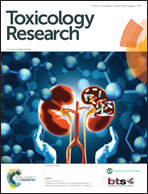Using 3D MCF-7 mammary spheroids to assess the genotoxicity of mixtures of the food-derived carcinogens benzo[a]pyrene and 2-amino-1-methyl-6-phenylimidazo[4,5-b]pyridine
Abstract
Genotoxic carcinogens are present in the human diet, and two important examples are benzo[a]pyrene (BaP) and 2-amino-1-methyl-6-phenylimidazo[4,5-b]pyridine (PhIP). BaP is a polycyclic aromatic hydrocarbon generated by incomplete combustion of organic substances, thus contaminating numerous foodstuffs, and PhIP is a heterocyclic amine formed when meat is cooked. Genotoxicity testing of chemical carcinogens has focussed largely on individual chemicals, particularly in relation to diet, despite mixtures representing a more realistic exposure scenario. We have previously shown that exposure of MCL-5 cells to BaP–PhIP mixtures produces a TK mutation dose response that differs from the predicted additive response, using traditional regulatory-like two-dimensional (2D) cell culture. There is a large gap between 2D cell culture and the whole animal, and three-dimensional (3D) cell culture, shown to better represent in vivo tissue structure, may bridge the gap. The aim of the current study was to use 3D spheroids to characterise the DNA damage response following exposure to mixtures of the mammary carcinogens BaP and PhIP. Mammary MCF-7 cells were grown in 3D spheroids, exposed (24 h) to BaP (10−10 to 10−5 M) or PhIP (10−9 to 10−4 M) individually or in mixtures and DNA damage assessed by micronucleus (MN) formation. A dose-dependent increase in MN was observed for the individual chemicals in 3D cell culture. In line with our previous 2D TK mutation data, 3D mixture exposures gave a modified DNA damage profile compared to the individual chemicals, with a potent response at low dose combinations and a decrease in MN with higher concentrations of BaP in the mixture. Ethoxyresorufin-O-deethylase (CYP1A) activity increased with increasing concentration of BaP in the mixture, and for combinations with 10 μM BaP, CYP1A1 mRNA induction was sustained up to 48 h. These data suggest mixtures of genotoxic chemicals give DNA damage responses that differ considerably from those produced by the chemicals individually, and that 3D cell culture is an appropriate platform for DNA damage assays.
![Graphical abstract: Using 3D MCF-7 mammary spheroids to assess the genotoxicity of mixtures of the food-derived carcinogens benzo[a]pyrene and 2-amino-1-methyl-6-phenylimidazo[4,5-b]pyridine](/en/Image/Get?imageInfo.ImageType=GA&imageInfo.ImageIdentifier.ManuscriptID=C5TX00343A&imageInfo.ImageIdentifier.Year=2016)

 Please wait while we load your content...
Please wait while we load your content...